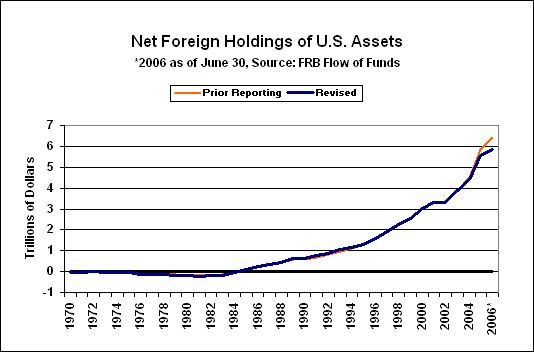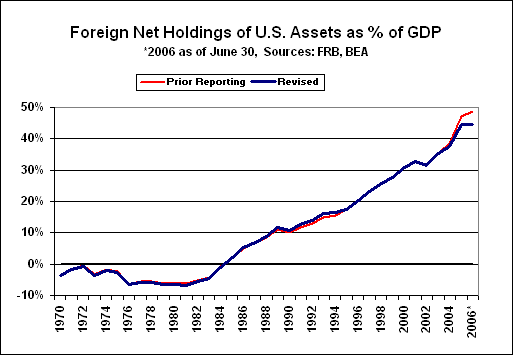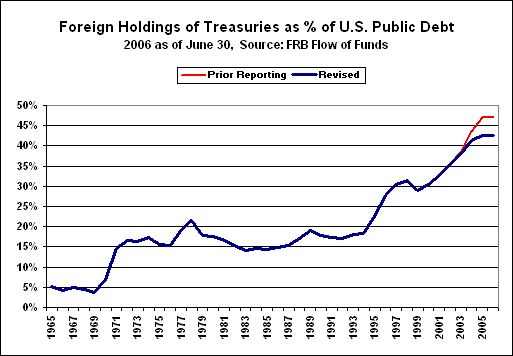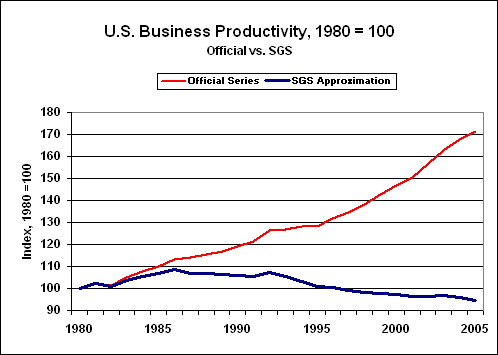Flow of Funds Shenanigans The Productivity “Miracle”
Reporting/Market Focus from the October 2006 Edition of the SGS Newsletter
Quarterly Update: Federal Reserve Flow of Funds Accounts. If you have an intractable economic problem, you can try to make it go away by altering or eliminating key data series. If the economy is damaged by a "free trade" agreement, just redefine GDP methodology and spike productivity growth. If the government wants to reduce cost-of-living adjustments for Social Security recipients, without going public on the effort, just reduce reported CPI. If the central bank is going to be spiking the broad money supply, just eliminate M3 reporting. If there is a problem with foreign investors holding too much Treasury debt, just define them away.
We noted when first publishing the Federal Reserve’s Flow of Funds Data three months ago that it was subject to the foibles of the national income (NIPA) accounts, including GDP. So long as the GDP methodology stays constant, the relative flow changes should have some significance. The GDP methodology, however, has been altered and so has the reported flow of funds.
From those same people who took away M3, now comes a revision in the flow of funds that helps make another problem start to fall of the financial markets’ radar screen. The methodological issues will be addressed in November’s Reporting/Market Focus.
In recent methodological revisions to the services sector of the trade data, the Bureau of Economic Analysis made the balance of payments problem appear less significant than it had been. If the net flow of cash to the rest of the world is reduced on an historical basis, however, that means the rest of the world does not hold as many dollars as previously thought. If that is the case, then the flow of funds data have to be adjusted.
Correcting for the "improved" trade data, the Federal Reserve adjusted its flow-of-funds numbers. As a result, the Rest of World category’s total assets at the end of 2005 was revised from $11,106.9 billion to $11,029.4 billion, a drop of $77.5 billion.
Somehow, that translated to Rest of World holdings of U.S. Treasury securities dropping from $2,196.8 billion to $1,993.8 billion, a decline of $203.0 billion. Fortunately, however, U.S. Treasury debt issuance is not vulnerable yet to creative revisions. So, if the total level of Treasury issuance stayed the same, who bought the Treasuries the that Rest of World no longer owns?
Thank goodness for U.S. households! Their holdings of U.S. Treasuries as of year-end 2005 revised from $368.8 billion to $551.5 billion, increasing by an incredible 50%, or $182.7, which is exactly 90.0% of the reduction in the Rest of World category.
Personally, I get nervous when I see too many exact numbers in government data that have zeros in them, although that does happens at random. It almost looks like someone said, "Let’s allocate 90% of the Treasuries lost by the Rest of World to the Household category."



The graphs shown above reflect the revisions and a pattern of dampening growth in U.S. dependence on foreign capital. While the series still shows a serious problem that will trigger an eventual collapse in the financial system, the reliability of the data has been seriously compromised by the latest revisions, and the numbers simply are not credible.
The new data imply reductions in the recent net foreign acquisition of U.S. Treasuries as a percent of Treasury issuance. Previous numbers showed foreign investors acquiring enough net Treasuries to account for 101.1%, 96.5% and 84.5%, respectively, of net Treasury debt issuance in 2004, 2005 and the 12 months ended June 2006. The new proportions are, respectively, 80.0%, 61.9% and 37.4%.
If the Fed’s new numbers were accurate, the dollar would be much weaker, and long-term Treasury yields would be much higher. The data are not accurate.
Productivity. When the Fed Chairman touts an economic miracle, it almost certainly means that officials have been playing with their numbers, not that the Deity has intervened in the economy.
Subscribers occasionally ask why SGS does not cover the quarterly U.S. productivity numbers. The answer is that those numbers are of such poor quality that they hardly are worth wasting computer memory storage on them. Where the Federal Reserve and recent administrations have patted each other on the back tied to the heavily touted productivity "miracle," SGS looks at current and historical productivity adjusted for some of the same methodological gimmicks that have been built into GDP and inflation reporting over the decades.
Contrary to one of Wall Street’s favorite myths, productivity is not improving economic and business conditions year after year. While productivity gains are obvious in many areas of business, productivity for the broad economy has been in decline since the miracle of NAFTA.
Productivity broadly is measured as output per hour of all persons. The series is published quarterly and updated monthly by the Bureau of Labor Statistics. Generally, productivity is a measure of production, divided by a measure of labor. The production measure used is a stripped down version of the GDP. It excludes government, non-profit institutions and private households, which leaves about 78% of the GDP intact. The labor measures are based on the sampling done for the household survey of employment, adjusted for the same eliminations as production. Neither of the two series is of good quality, so it is difficult to expect a ratio of the two data sets to have much meaning.
The graph below plots the officially reported level of productivity per year, with 1980 set at 100, along with an SGS alternate version.

The top line reflects the reported productivity miracle; the bottom is the rough SGS estimate, adjusted for removing methodological gimmicks that were added over time. Of some interest, the SGS line turns down after the signing of the North American Free Trade Agreement (NAFTA) late in 1992. NAFTA went into effect the first of 1994.
Why would this or any such treaty purportedly designed to stimulate the U.S. economy drive productivity lower? Simply put, the academic imbeciles, who sold the concept, forgot to emphasize to those who bought the concept, that both parties entering into such an agreement had to be at full employment in order to realize mutual benefit.
The end result has been an explosive growth in new trade deficits with Mexico and Canada. As to productivity, consider eliminating the jobs of highly skilled production workers and machinists and turning them into hamburger flippers. It is hard to imagine how that translates into a productivity miracle.